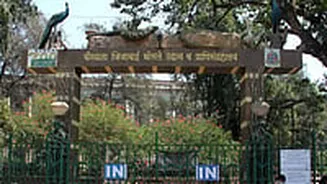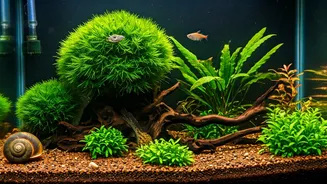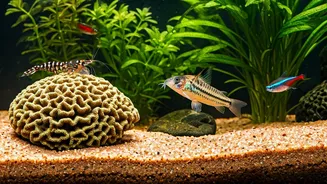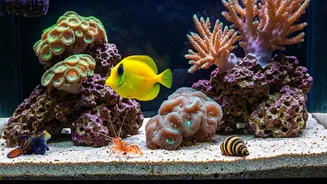Introduction: Ecosystem Wonders
Aquariums, though seemingly self-contained environments, thrive on balance. Maintaining a clean and healthy aquarium is a crucial task for any fish keeper.
While filters and regular water changes are essential, nature provides help in the form of specialized creatures, each with a unique role to play in keeping the water clear and the ecosystem thriving. This article unveils five remarkable inhabitants, each contributing in a unique way to the overall health and visual appeal of an aquarium. These creatures are not just decorative; they are integral parts of a complex ecosystem, working diligently to maintain balance and beauty within the confined space of a fish tank. They showcase the remarkable efficiency and synergy found in natural systems, offering a glimpse into the wonders of aquatic life and the importance of biodiversity in maintaining a healthy environment. By integrating these species into your aquariums, one can achieve a more natural and balanced ecosystem, reducing the workload of aquarium maintenance and promoting the well-being of the fish.
1. The Snail Squad
Snails, frequently underestimated, are invaluable aquarium cleaners. These gastropods come in various forms, each with unique cleaning habits. Some, like the Nerite snail, excel at consuming algae from glass, decorations, and plants, leaving surfaces spotless. Others, like Malaysian trumpet snails, burrow in the substrate, aerating the gravel and preventing the buildup of harmful gases. Their relentless grazing habits prevent unsightly algae blooms, contributing significantly to a cleaner aquarium. They continuously graze, removing algae and detritus, which benefits the water quality. The snail squad not only contributes to the aesthetic cleanliness of the tank but also helps regulate the levels of organic waste. Snails' natural behaviors contribute to a more stable and balanced aquarium ecosystem, making them a great addition to most freshwater and marine setups. The variety of snail species ensures a diverse approach to cleaning, catering to various aquarium needs. These hard-working creatures are a testament to nature's efficiency, turning waste into nutrients and keeping the aquarium environment healthy and visually appealing.
2. The Shrimp Crew
Aquarium shrimp, especially varieties like the Cherry shrimp and Amano shrimp, are renowned for their cleaning prowess. These tiny crustaceans are voracious eaters of algae, detritus, and uneaten food, preventing the buildup of waste that can cloud the water and harm fish. Their constant foraging keeps surfaces clean and helps manage decaying organic matter. The shrimp crew, with their tireless work ethic, keeps the tank pristine. They navigate throughout the tank, reaching hard-to-access areas and consuming even the smallest particles of waste, helping maintain a high water quality. Certain species, such as Amano shrimp, are known for tackling more challenging algae types. Their presence contributes to a more balanced and healthy ecosystem, reducing the need for excessive manual cleaning and chemical treatments. They not only clean but also provide a visual appeal, adding movement and interest to the aquarium. Their efforts make a significant difference in reducing the overall workload, creating a cleaner and more aesthetically pleasing environment for both the fish and the observer.
3. The Bottom Feeders
Various species of catfish and loaches make excellent bottom feeders, dedicating their time to keeping the substrate clean. These fish are adapted to consuming food particles and decaying matter that settles at the bottom of the aquarium, preventing the accumulation of waste and the buildup of harmful substances. Corydoras catfish, for example, sift through the substrate, consuming uneaten food, while loaches like the Kuhli loach help in aerating the substrate. These bottom-dwelling cleaners work continuously, turning over the substrate and preventing the formation of anaerobic pockets, which can harbor harmful bacteria. Their constant activity helps maintain water quality and prevents the buildup of dangerous gases, ensuring a healthy environment for the aquarium's inhabitants. By controlling the accumulation of decaying matter, these bottom feeders contribute to a balanced ecosystem and reduce the risk of common aquarium problems. They contribute to the visual appeal by being active and interesting to observe as they forage for food.
4. The Algae Eaters
Specialized fish species are often included in aquariums to directly combat algae growth. These fish, such as the Otocinclus catfish and some species of plecos, have specialized mouthparts and feeding habits that make them highly efficient algae consumers. Otocinclus, for example, will diligently graze on algae from surfaces, while plecos, such as the bristlenose pleco, are efficient at controlling various types of algae. By actively consuming algae, these fish help keep the aquarium clean and prevent unsightly algal blooms. Their presence reduces the need for frequent manual cleaning of the tank, and their efforts also support the health of plants within the aquarium. By controlling algae, these fish help create a more balanced ecosystem, which promotes the overall health of the tank. They are a welcome addition and a visual enhancement to the aquarium. These specialized algae-eating fish offer a natural and effective method to control algae, contributing to a cleaner and more beautiful aquatic environment.














